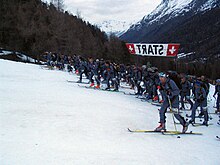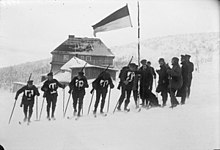Ski mountaineering



Ski mountaineering (abbreviated to skimo)[1] is a skiing discipline that involves climbing mountains either on skis or carrying them, depending on the steepness of the ascent, and then descending on skis. There are two major categories of equipment used, free-heel Telemark skis and skis based on Alpine skis, where the heel is free for ascents, but is fixed during descent.[2] The discipline may be practiced recreationally or as a competitive sport.[3]
Competitive ski mountaineering is typically a timed racing event that follows an established trail through challenging winter alpine terrain while passing through a series of checkpoints. Racers climb and descend under their own power using backcountry skiing equipment and techniques. More generally, ski mountaineering is an activity that variously combines ski touring, Telemark, backcountry skiing, and mountaineering.[3]
History[]

Military patrol was an official event at the 1924 Winter Olympics, followed by demonstration events at the 1928 Winter Olympics, in 1936 and in 1948. Military patrol is considered to be a predecessor of the biathlon.[citation needed]
From 1992 to 2009, the Comité International du Ski-Alpinisme de Compétition (CISAC), founded by France, Italy, Slovakia, Andorra and Switzerland, sanctioned the European Championship.[4] Then the CISAC merged with the International Council for Ski Mountaineering Competitions in 1999, which in 2008 became the International Ski Mountaineering Federation (ISMF).[citation needed]
Outside Europe, international championships started with the 2007 South American Ski Mountaineering Championship and the 2007 Asian Championship of Ski Mountaineering. The 2012 North American Ski Mountaineering Championship was the first edition of a North American Championship of Ski Mountaineering, sanctioned by the United States Ski Mountaineering Association.[citation needed]
In July 2020, the International Olympic Committee announced that Ski Mountaineering had been added as a new sport at the 2026 Winter Olympics in Milan Cortina, following a successful debut of the sport at the 2020 Winter Youth Olympics.
Competition[]
International competition is sanctioned by the International Ski Mountaineering Federation, while national bodies sanction national competitions, for example the United States Ski Mountaineering Association (USSMA),[5] Ski Mountaineering Competition Canada (SMCC),[6] and the Schweizer Alpen Club (Switzerland).[7]
Three important races are the Italian Mezzalama Trophy, the Swiss Patrouille des Glaciers, and the French Pierra Menta.[8]
Equipment[]
- Bindings: Should be reliable, light, and durable.[9]
- Boots: Should be light and flexible.[9]
- Skis: Should weigh 4 pounds (1.8 kg) or less.[9]
- Other: Ski skins are used for walking up slopes.[citation needed]
References[]
- ^ Editors (2018). "Definition of "skimo"". Oxford Dictionaries | English. Retrieved 2018-12-27.CS1 maint: extra text: authors list (link)
- ^ Havell, Kim (March 6, 2002). "Find the Right Gear—Tip from Walter Laserer". Outside Magazine. Retrieved 2016-01-30.
- ^ Jump up to: a b Volken, Martin; Schell, Scott; Wheeler, Margaret (2007). Backcountry Skiing: Skills for Ski Touring and Ski Mountaineering. Outdoor Expert Series. The Mountaineers Books. p. 339. ISBN 978-1594850387.
- ^ Claude Défago: Die Geschichte des Skialpinismus Archived 2011-07-07 at the Wayback Machine (German).
- ^ "The United States Ski Mountaineering Association". USSMA. Retrieved 17 October 2014.
- ^ "Ski Mountaineering Competition Canada". SMCC. Retrieved 17 October 2014.
- ^ "Actualité ski-alpinisme". Archived from the original on 26 October 2014. Retrieved 17 October 2014..
- ^ "The 6 Hardest Ski Touring Races in the World". Ispo.com. Retrieved 2019-09-26.
- ^ Jump up to: a b c "FAQ". USSMA. Archived from the original on 2014-10-22. Retrieved 17 October 2014.
- Ski mountaineering
- Types of skiing
- Winter sports
- Mountaineering

